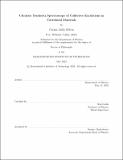Ultrafast Terahertz Spectroscopy of Collective Excitations in Correlated Materials
Author(s)
Belvin, Carina Aiello
DownloadThesis PDF (52.78Mb)
Advisor
Gedik, Nuh
Terms of use
Metadata
Show full item recordAbstract
Strongly correlated materials exhibit a multitude of exotic phases of matter. Originating from strong interactions between electrons, the properties of these systems are governed by a delicate balance among the lattice, charge, orbital, and spin degrees of freedom, leading to complex ground state phases. The lowest-energy collective excitations of a particular ground state serve as a fingerprint of the phase of matter, and revealing such collective modes can therefore provide crucial information for understanding the underlying microscopic interactions. A powerful means of experimentally observing collective excitations in solids is through ultrafast spectroscopy. In this technique, an intense, ultrashort “pump” laser pulse drives the material out of equilibrium, and a subsequent weaker “probe” pulse detects the altered state of the system. By tailoring the parameters of the pump pulse, one can either lightly perturb the material to measure its equilibrium properties or drive it into an entirely new phase of matter markedly different from its original state. In either regime, the pump pulse can coherently generate collective excitations, which can be mapped in both the frequency and time domains.
In this thesis, we use ultrafast terahertz spectroscopy to investigate collective modes in strongly correlated materials. The terahertz spectral range is the natural energy scale of elementary collective excitations in solids, and thus terahertz spectroscopy is an ideal method for detecting such modes. To drive the system out of equilibrium, we employ pump pulses in the near infrared that are chosen to lie above, below, or resonant with specific electronic transitions in the material. This enables us to observe the dynamics of collective modes after various types of perturbations, which can offer insight into the nature of complex phases and the couplings between different degrees of freedom. In this work, we utilize this approach to reveal new electronic soft modes of the charge-orbital order in magnetite, the interplay between excitons and magnons in the van derWaals antiferromagnet NiPS₃, the crossover between distinct optical generation mechanisms of a coherent magnon in NiPS₃, and the dynamics of coherent electromagnons in the van der Waals multiferroic NiI₂.
Date issued
2022-05Department
Massachusetts Institute of Technology. Department of PhysicsPublisher
Massachusetts Institute of Technology